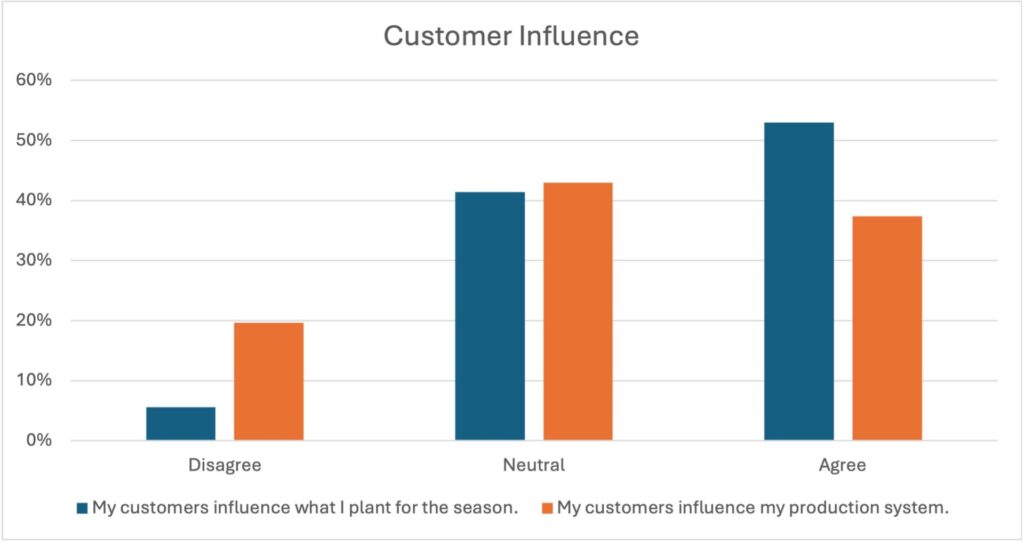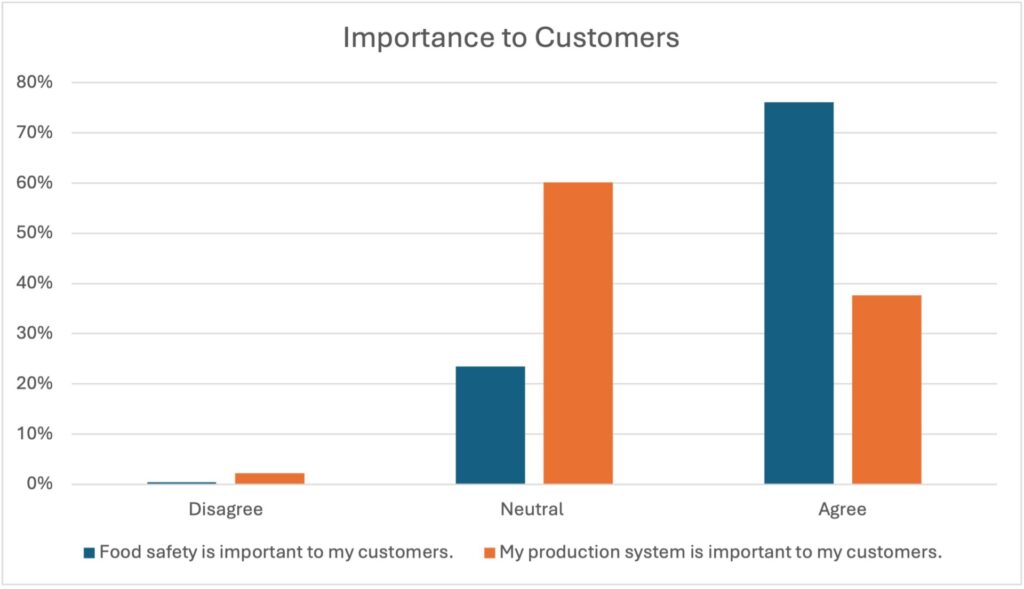In a producer survey done in 2024-2025 by the Soil to Market Team (Maria Marshall, Renee Wiatt, Petrus Langenhoven, Betty Feng, and Nathan Shoaf), small and medium farms were asked questions related to decisions, operations, and people on the farm. Some of those questions inquire about their interactions with and considerations of customers. From interacting with customers to let them know what the farm is selling to farmers making decisions on what to grow (that customers will buy), these interactions and decisions can be complex.
Of the 500 small and medium-sized vegetable farmers surveyed, approximately 52% were categorized as small and 48% as medium. USDA defines small family farms as those with an annual gross cash flow income (GCFI) of less than $350,000; mid-size farms have a GCFI of $350,000 to $999,999; and large-scale farms are those with a GCFI of $1 million or more (Dorn, 2021). Large-scale farms were excluded from this survey and analysis.
Customer service can be complex for farmers and farm producers (Dethloff et al., 2022), and this may be reflected in their primary business goal. When asked about goals, 85% of vegetable farmers ranked profit as their most important goal, and only 8% responded that a positive reputation with customers was their most important goal. Other goals included business survival, keeping the business in the family, and the opportunity to work with family. Customers can heavily influence the profitability and success of a farm business. When asked about customer influence on what is planted for the season and the production system utilized, only 53% agreed that customers influence what they plan, and 37.2% agreed that customers influence their production system (Figure 1).
The survey also inquired about what farmers believed was important to their customers. When asked about food safety and their production systems, more farmers thought that food safety was important to their customers. Roughly 76% of farmers believed that food safety was important to customers and only 37.6% of farmers believed that the production system was important to them (Figure 2).
Lastly, farmers were asked about how much they communicate their production practices to their customers. On a scale from one to six, where one is “none at all” and six represents “a great deal”, farmers were least likely to report “none at all” and “a great deal”. Roughly 26% of farmers responded that they communicated production practices “a lot” (5), and roughly 39% responded that they communicated production practices “a moderate amount” (4).
According to Hyken (2023) with Forbes, transparency with customers can build trust and culminate in a more positive experience for customers. Although the Soil to Market producer survey only focused on the farmer, the data reveal a positive correlation between farm profitability and the extent to which the farmer communicated production practices. There are likely benefits to farmers (as well as their customers) for being communicative about their farm operation and practices.
References
Dethloff, N., Van Leuven, A., and Bir, C. (2022, October). Customer service basics for agricultural entrepreneurs. Oklahoma Cooperative Extension Service, AGEC-920. https://extension.okstate.edu/fact-sheets/customer-service-basics-for-agricultural-entrepreneurs.html.
Dorn, T. (2021, January 27). Family farms continue to power U.S. agriculture. U.S. Department of Agriculture. https://www.usda.gov/about-usda/news/blog/family-farms-continue-power-us-agriculture
Hyken, S. (2023, January 29). Radical transparency: A key to a better customer experience. Forbes. https://www.forbes.com/sites/shephyken/2023/01/29/radical-transparency-a-key-to-a-better-customer-experience/
Wiatt, R., Marshall, M.I., Feng, Y., Langenhoven, P., and Shoaf, N. (2024-2025). Soil to Market Producer Survey on Integrated Decision-Making Survey [data file and codebook]. IRB-2024-1552. Funded by USDA-NIFA-AFRI: Taking the Next Step as a Small and Medium Sized Farm: Understanding the Integration of Production, Food Safety, and Profitability
Funding Acknowledgement
This work is supported by the Agriculture Food Research Initiative-Small and Medium Sized Farms Program, project award no. 2021-68006-33893, from the U.S. Department of Agriculture’s National Institute of Food and Agriculture.
Any opinions, findings, conclusions, or recommendations expressed in this publication are those of the author(s) and should not be construed to represent any official USDA or U.S. Government determination or policy.


